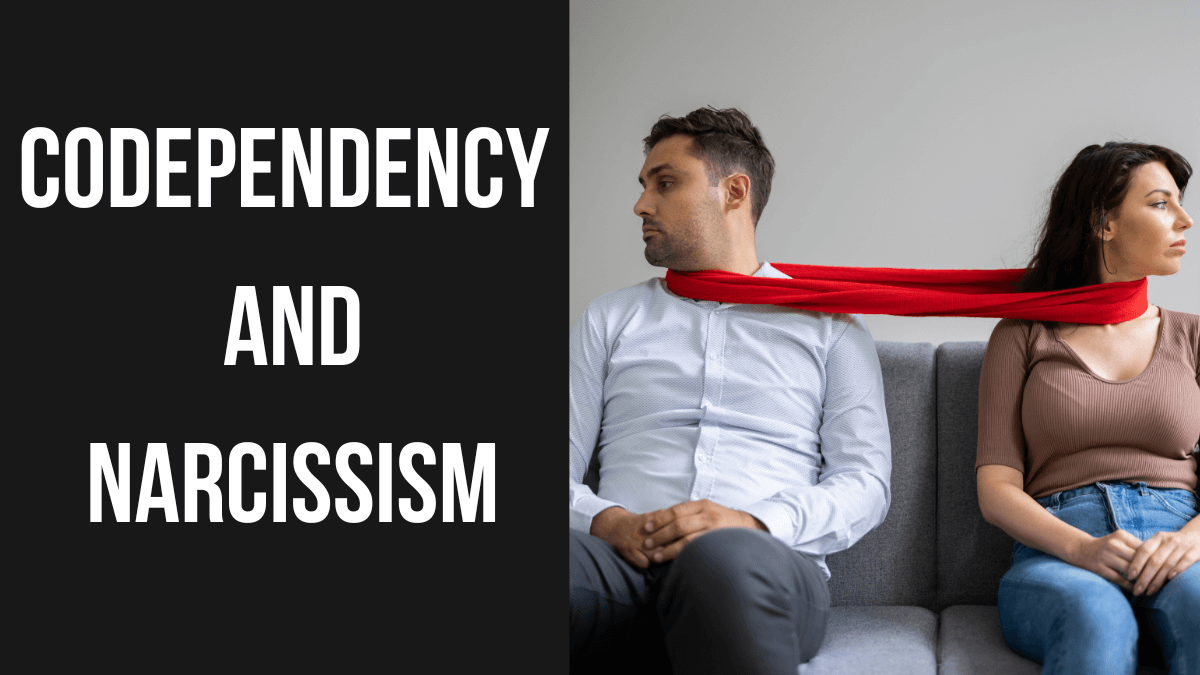Codependency and narcissism are two terms that have been used quite frequently in recent years to describe different patterns of behavior in relationships. Codependency is a term that was originally used to describe the behavior of individuals who were in relationships with alcoholics or drug addicts.
Over time, the term has been expanded to include a range of behaviors that involve a dysfunctional relationship between two individuals, where one person is dependent on the other for their emotional well-being. Narcissism, on the other hand, refers to a personality disorder characterized by an excessive sense of self-importance, a lack of empathy, and an overwhelming need for admiration. In this article, we will explore what codependency is and how it relates to narcissism.
You will read in this article:
- What is Codependency?
- Signs of Codependency
- Causes of Codependency
- Different shapes of relationships between codependents and Narcissists
- Examples of Codependency and Narcissist relationships
- How to break the cycle of codependency?
What is Codependency?

In the context of narcissism, codependency refers to a pattern of behavior where one person (the codependent) enables and accommodates the needs, wants, and desires of a narcissistic individual.
Codependency can manifest in various ways, such as prioritizing the needs of the narcissist over one’s own needs, constantly seeking validation and approval from the narcissist, and tolerating or excusing their abusive behavior. Codependents often develop an unhealthy dependence on the narcissist and may struggle to set healthy boundaries or assert their own needs and desires.
This dynamic can be extremely toxic and can lead to emotional, psychological, and even physical harm for the codependent individual.
Signs of Codependency
1.Obsessive focus on others
Codependents may put the needs of others ahead of their own to an extreme degree, to the point where they neglect their own well-being in order to help others.
2. Difficulty setting boundaries
Codependents often have difficulty saying “no” or setting boundaries with others, even if they are being taken advantage of or mistreated.
3. Low self-esteem
Codependents may have a poor sense of self-worth and may rely on the approval of others to feel good about themselves.
4. People-pleasing behavior
Codependents may engage in people-pleasing behavior in order to gain approval or love from others, even if it means sacrificing their own needs or values.
5. Fear of abandonment
Codependents may be afraid of being abandoned or rejected by others, which can lead to them staying in unhealthy relationships or tolerating abusive behavior.
6. Enabling behavior
Codependents may enable the destructive behavior of others, such as substance abuse or narcissistic behavior, by making excuses for them or trying to cover up their behavior.
7. Difficulty expressing emotions
Codependents may have difficulty expressing their own emotions or needs, which can lead to feelings of resentment or being taken advantage of.
8. Control issues
Codependents may feel a need to control or “fix” the behavior of others, which can lead to unhealthy and dysfunctional relationships.
Causes of Codependency
Codependency in the context of narcissism can have various causes, including childhood experiences such as growing up with a narcissistic parent or caregiver who was emotionally unavailable or neglectful.
Codependency can also be caused by a person’s own personality traits, such as low self-esteem, a need for approval, and a tendency to put others’ needs before their own.
Additionally, people who have experienced trauma, abuse, or other forms of emotional distress may be more likely to develop codependency as a way to cope with their experiences.
In the context of narcissism, codependency can also develop as a result of a relationship with a narcissistic partner or family member, where the codependent person feels responsible for the narcissist’s emotional well-being and may become enmeshed in their demands and needs.
The Relationship Between Codependency and Narcissism (Different shapes)

Codependency and narcissism often coexist in a toxic and dysfunctional relationship. In this relationship, the codependent person is often attracted to the narcissistic person’s charm, confidence, and assertiveness.
However, the narcissistic person is emotionally unavailable and lacks empathy, which can leave the codependent person feeling neglected and unimportant.
Here are different shapes of the relationship between Codependency and Narcissism
A. Codependency and Narcissism as Co-Dependents
Codependency and narcissism are often described as co-dependent because they feed off each other in a negative cycle. The narcissist’s need for attention, control, and admiration fuels the codependent’s need for approval and validation, while the codependent’s willingness to tolerate the narcissist’s behavior reinforces the narcissist’s sense of entitlement and superiority.
This cycle creates a toxic relationship where the codependent loses their sense of self and becomes overly focused on the narcissist’s needs, while the narcissist takes advantage of the codependent’s willingness to sacrifice their own needs.
In essence, the codependent needs the narcissist to feel needed and the narcissist needs the codependent to feel powerful. This dynamic can be difficult to break without professional help and support.
B. The Codependent’s Role in a Narcissistic Relationship
In a narcissistic relationship, the codependent’s role is to enable and support the narcissist’s behavior. The codependent often sacrifices their own needs and desires to please the narcissist, and may even take on the responsibility for the narcissist’s emotional wellbeing.
The codependent is often so focused on the narcissist that they lose sight of their own identity and become enmeshed in the narcissist’s life. The codependent may also experience feelings of guilt and shame, as well as a sense of powerlessness in the relationship.
Ultimately, the codependent’s role is to maintain the narcissistic dynamic, even at the cost of their own wellbeing.
C. The Narcissist’s Role in a Codependent Relationship
In a codependent relationship, the narcissist typically takes on the role of the dominant partner, using manipulation and control to maintain power over their codependent partner.
They may use their charm and charisma to draw in their partner and make them feel special, but will ultimately seek to meet their own needs at the expense of their partner’s. The narcissist may exploit the codependent’s need for validation and approval, using it to keep them hooked and reliant on the relationship.
They may also use gaslighting, blame-shifting, and other tactics to avoid taking responsibility for their actions and deflect criticism. In essence, the narcissist’s role in a codependent relationship is to maintain control and use the codependent’s emotional vulnerabilities to their own advantage.
Examples of Codependency and Narcissist Relationships
Here are five examples of codependent and narcissistic relationships:
1.The Enabler and the Addict
In this type of relationship, the codependent person (the enabler) enables the narcissistic partner’s (the addict) addiction by constantly making excuses for their behavior and covering up their mistakes. The narcissistic partner may take advantage of the codependent person’s need to be needed and use them for their own benefit.
2. The Martyr and the Victim
In this type of relationship, the codependent person (the martyr) feels a sense of responsibility for the narcissistic partner’s (the victim) emotional well-being. The narcissistic partner may manipulate the codependent person by playing the victim and making them feel guilty for not doing enough to help them.
3. The Caretaker and the Taker
In this type of relationship, the codependent person (the caretaker) feels a sense of responsibility for the narcissistic partner’s (the taker) happiness and well-being. The narcissistic partner may take advantage of the codependent person’s kindness and generosity by constantly demanding their attention and resources.
4. The Peacemaker and the Controller
In this type of relationship, the codependent person (the peacemaker) tries to keep the peace by accommodating the narcissistic partner’s (the controller) every whim. The narcissistic partner may use their power and control to manipulate the codependent person into doing what they want, even if it goes against their own desires or needs.
5. The Rescuer and the Savior
In this type of relationship, the codependent person (the rescuer) feels a sense of responsibility for saving the narcissistic partner (the savior) from their problems or issues. The narcissistic partner may use their need for validation and admiration to manipulate the codependent person into doing everything for them, while taking credit for their successes and blaming them for their failures.
Breaking the Cycle of Codependency and Narcissism

Here are some steps to break the cycle of codependency and narcissism:
A. Recognizing the Patterns of Codependency and Narcissism
Recognizing the patterns of codependency and narcissism is the first step to breaking free from their cycle. This involves understanding the signs and symptoms of codependency and narcissism and how they manifest in relationships. It also involves becoming aware of one’s own behavior and thought patterns that may contribute to the cycle.
This self-awareness can help individuals identify and address their own codependent tendencies and set boundaries with narcissistic individuals. Seeking therapy or support groups can also be helpful in gaining a deeper understanding of codependency and narcissism and learning strategies to break free from their cycle.
B. Developing Healthy Boundaries
The second step to break the cycle of codependency and narcissism is to develop healthy boundaries. Codependents often struggle with setting boundaries and saying “no,” which allows the narcissist to continue their behavior. It’s important to recognize that setting boundaries is not a selfish act, but rather a necessary step in protecting one’s own well-being.
This involves identifying one’s needs and communicating them assertively, while also respecting the needs of others. In addition, it’s important to establish consequences for violating boundaries and to follow through with them. Developing healthy boundaries is a crucial step in breaking free from the cycle of codependency and narcissism.
C. Seeking Professional Help
The third step in breaking the cycle of codependency and narcissism is seeking professional help. Codependency and narcissism are complex issues that can be challenging to address alone. Seeking the help of a therapist or counselor who specializes in codependency and narcissism can be extremely helpful.
These professionals can provide a safe and supportive environment to explore your feelings and behaviors, develop healthy coping strategies, and work through the underlying issues that may be contributing to your codependency or narcissism.
Additionally, they can help you to identify and address any other mental health conditions that may be impacting your ability to break free from the cycle of codependency and narcissism. It is important to remember that seeking professional help is not a sign of weakness, but rather a courageous step towards healing and self-improvement.
For professional help consider Psychologytoday.com.
D. Support Groups for Codependency and Narcissism
Support groups can be an essential part of recovery from codependency and narcissism. It is a safe and supportive environment where people can share their experiences, receive support and learn new coping strategies. Some of the most common support groups for codependency and narcissism include:
- Codependents Anonymous (CoDA): This is a 12-step program that provides support for people who struggle with codependency.
- Adult Children of Narcissists (ACoN): This support group is specifically for people who have grown up with a narcissistic parent.
- Surviving Narcissism: This is an online podcast that offers resources and support for people who have been in a relationship with a narcissist.
- Narcissistic Abuse Recovery: This is a support group on Facebook that offers support and guidance for people who have experienced narcissistic abuse.
- Emotional Abuse Recovery and Resilience: This is another support group on Facebook that offers support for people who have been in an emotionally abusive relationship.
Joining a support group can be a crucial step in the recovery process. It can provide a sense of community and validation, which can be essential in healing from the effects of codependency and narcissism.
Recap of Codependency and narcissism
In summary, codependency refers to a pattern of behavior in which an individual prioritizes the needs and desires of others above their own to an unhealthy extent. In the context of narcissism, codependency often manifests in relationships with narcissistic individuals who prioritize their own needs and desires above all else, leading to a cycle of codependency and narcissism.
The signs and symptoms of codependency in the context of narcissism include an excessive focus on the needs and desires of the narcissist, low self-esteem, a tendency to neglect one’s own needs, and difficulty setting and maintaining healthy boundaries.
Breaking free from the cycle of codependency and narcissism involves recognizing the patterns of codependency and narcissism, developing healthy boundaries, seeking professional help, and potentially joining a support group. It is a process that requires time, effort, and self-reflection, but ultimately can lead to greater self-awareness, self-esteem, and healthier relationships.
Frequently asked Questions
- Can a Narcissist be a Codependent?
Ans: Yes, it is possible for a narcissist to be codependent. Codependency and narcissism are often seen as opposite ends of a spectrum, with codependents being overly selfless and narcissists being overly self-centered. However, there are cases where a person can exhibit traits of both codependency and narcissism. This is known as a “covert narcissist” or a “vulnerable narcissist”.
These individuals often seek validation and attention from others while also manipulating and controlling those around them. They may also struggle with feelings of low self-worth and shame, which can contribute to their codependent behaviors.
2. Can a Codependent and Narcissist relationship work?
A codependent and narcissist relationship is typically unhealthy and dysfunctional. While it may work in the short term, over time, it is unlikely to be sustainable. The codependent may continue to enable the narcissist’s behavior, which reinforces the narcissist’s sense of entitlement and lack of empathy.
The narcissist may continue to exploit the codependent’s need for approval and validation, leading to an imbalanced power dynamic. Ultimately, both parties may continue to suffer
3. Are codependent people drawn to narcissists?
Yes, it is common for codependent individuals to be drawn to narcissists. Codependency and narcissism can often create a toxic dynamic in which the codependent person becomes enmeshed in the narcissist’s need for validation and attention, while the narcissist exploits the codependent person’s willingness to sacrifice their own needs in order to maintain the relationship.
Codependent individuals may seek out relationships with narcissists because they may feel a sense of purpose and validation in being needed by someone who appears confident and powerful.
Additionally, codependent individuals may have a history of being in relationships with people who are emotionally unavailable or abusive, and may be drawn to the intense emotions and drama that often accompany relationships with narcissists.
Final Thoughts
In conclusion, codependency and narcissism are often intertwined in a destructive cycle. Codependents enable and feed the ego of narcissists, while the narcissist uses and manipulates the codependent for their own gain. Breaking free from this cycle requires recognizing the patterns, setting healthy boundaries, seeking professional help, and potentially joining support groups.
It is essential to remember that healing from codependency and narcissism is a long and challenging journey, but it is possible with commitment and effort. It is crucial to prioritize self-care, self-love, and healthy relationships to achieve long-term recovery and personal growth.
Sources
